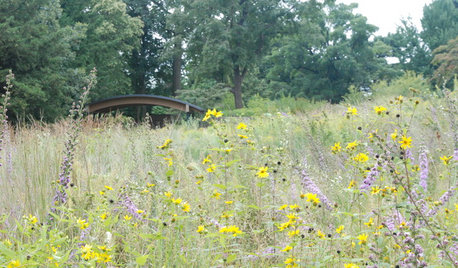Albizia julibrissin was introduced in 1745. Mostly called Mimosa, it is also called Silk Tree. It grows from New England to Florida, and as far west as Missouri and Illinois. It is also grown in California and some of the Pacific Northwest.
Many of the folks that grow it on purpose in the more northern areas (recent posts from Northern New Jersey and Connecticut are two examples) claim that it is not invasive there and request exemption from any disparaging comments about their desire to grow it.
But the USDA Forest Service reports that it is invasive in not just southern states but areas like New Jersey, Massachusetts, and West Virginia.
What makes a tree invasive? Does wide spread use do it? Lets take Crepe Myrtle as an example (introduced in the US in 1747, so mimosa has a two year head start on it). Crepe Myrtle is ubiquitous in metro Atlanta  two in every yard, large groups of them in business parks, up and down the highways in median strips. These guys should be popping up as invasive plants everywhere! Now I could be wrong  but IÂve never seen a volunteer crepe myrtle on the side of the road. I do see a few volunteers in my neighborÂs garden immediately underneath the tree. But they seem to go no further than that. If someone knows otherwise, please correct me! I do not work for the Forestry Commission.
Apparently, crepe myrtle has no invasive tendencies in this area. An exotic plant that is not invasive  they do exist. So wide spread use is perhaps not the reason that plants become invasive. It must be because some plants have reproductive capabilities that make them so  prolific seeds, vegetative means of propagation (like suckering), seeds that stay viable for many years, seeds that are carried far enough to start new colonies some distance from the parents. Mimosa has proven itself to have these reproductive capabilities.
But to be fair, Albizia julibrissin is not the only invasive tree in the US. A recent post on Garden Web talked about other Weed trees.
It is a matter of being responsible when it comes to known problem situations. Tallow tree (introduced in 1772) is not very well known in areas like Atlanta. I suppose there might be a few of them around. Therefore, I can assume that it is not invasive in the Atlanta area, right? It is such a fast grower! IÂll get some seeds from my friend in Florida, itÂll make a handsome shade tree for me. Wrong. I would not introduce such a known invasive plant. I have no doubt it will be invasive in this area eventually.
Tree of Heaven, Ailanthus altissima, was introduced in 1784 and is hugely invasive in Tennessee and becoming more so in North Georgia. It is considered invasive in even more states than mimosa according to the USDA Forest Service. Unfortunately it can be so ubiquitous that many people mistake it for a native plant  a native sumac (itÂs nickname is Stinking Sumac). Talk about the ultimate insult!
My hope is that people would be more responsible about what they plant. If mimosa was introduced in 1745, was it considered invasive in 1746? Of course not Âit takes time for these things to gain momentum and some invade faster than others. Ligustrum sinense (Chinese privet) was not introduced to the US until the early 1800s, but in the southeast, it has invaded and disturbed more acres of land than even kudzu and certainly more than mimosa. Again, many folks donÂt even realize it is NOT native, thatÂs how prevalent it is. "Why thatÂs just ol hedge, weÂve grown it for years!"
So for those of you that feel itÂs ok to plant just one more, compare yourselves to the folks that dump out their ashtray while stopped at the red light. ThereÂs already so many, whatÂs wrong with another, a few more? And for those of you that feel itÂs ok to plant one because "itÂs not invasive in my area", I think your time is coming. If youÂre seeing them on the side of the road, the trend as already revealed itself. Maybe you wonÂt be around when it happens, it could be years from now, but you contributed.


















snasxs
alabamatreehugger 8b SW Alabama
Related Professionals
Middle Island Landscape Architects & Landscape Designers · Montgomeryville Landscape Architects & Landscape Designers · Harvey Landscape Architects & Landscape Designers · Burien Landscape Contractors · Dudley Landscape Contractors · Pahrump Landscape Contractors · Annapolis Siding & Exteriors · Bountiful Siding & Exteriors · Malden Siding & Exteriors · Wareham Siding & Exteriors · Waukegan Siding & Exteriors · Crystal Lake Decks, Patios & Outdoor Enclosures · Framingham Decks, Patios & Outdoor Enclosures · Quincy Decks, Patios & Outdoor Enclosures · Tysons Corner Stone, Pavers & Concretesaccharum
treeguy123
quirkyquercus
snasxs
lkz5ia
supertyphoon
alabamatreehugger 8b SW Alabama
snasxs
quirkyquercus
pineresin
pineresin
lkz5ia
treeguy123
januszb
snasxs
quirkyquercus
saccharum
snasxs
saccharum
snasxs
saccharum
Iris GWOriginal Author
lkz5ia
snasxs
quercus_macrocarpa
quirkyquercus
lkz5ia
januszb
alabamatreehugger 8b SW Alabama
supertyphoon
snasxs
dodgerblue
snasxs
pineresin
quirkyquercus
philinsydney1
alabamatreehugger 8b SW Alabama
quirkyquercus
dottie_in_charlotte
quirkyquercus
alabamatreehugger 8b SW Alabama
pineresin
quercus_macrocarpa
jqpublic
lkz5ia
wisconsitom
alabamatreehugger 8b SW Alabama
quercus_macrocarpa